Related Research Articles

Avul Pakir Jainulabdeen Abdul Kalam was an Indian aerospace scientist and statesman who served as the 11th President of India from 2002 to 2007. He was born and raised in Rameswaram, Tamil Nadu and studied physics and aerospace engineering. He spent the next four decades as a scientist and science administrator, mainly at the Defence Research and Development Organisation (DRDO) and Indian Space Research Organisation (ISRO) and was intimately involved in India's civilian space programme and military missile development efforts. He thus came to be known as the Missile Man of India for his work on the development of ballistic missile and launch vehicle technology. He also played a pivotal organisational, technical, and political role in India's Pokhran-II nuclear tests in 1998, the first since the original nuclear test by India in 1974.

Arjuna, also known as Partha and Dhananjaya, is one of the chief protagonists of the Hindu epic Mahabharata. In the epic, he is the third among five Pandava brothers, from the royal line of the Kuru Kingdom. In the Mahabharata War, Arjuna was a key warrior from the Pandava side and killed many warriors including his own brother Karna and his grandfather Bhishma. Before the beginning of the war, his mentor, Krishna, gave him the supreme knowledge of Bhagavad Gita to overcome his moral dilemmas.
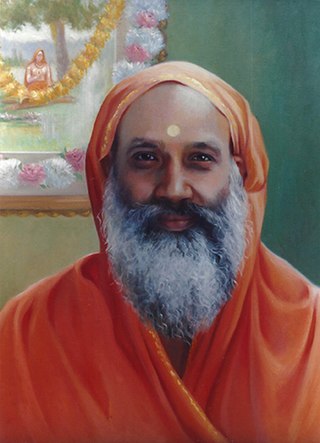
Swami Dayananda Saraswati was a renunciate of the Hindu order of sannyasa, a renowned traditional teacher of Advaita Vedanta, and founder of the Arsha Vidya Gurukulam and AIM For Seva.

Krishna Dvaipayana, better known as Vyasa or Vedavyasa, is a revered sage portrayed in most Hindu traditions. He is traditionally regarded as the author of the epic Mahabharata.
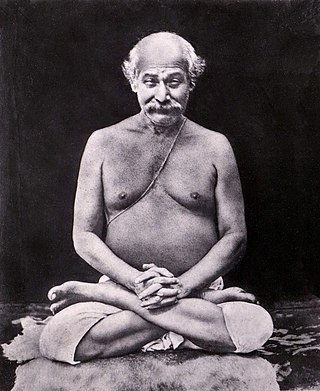
Shyama Charan Lahiri, best known as Lahiri Mahasaya, was an Indian yogi guru who founded the Kriya Yoga school. In 1861, his non-physical master Mahavatar Babaji appeared to him, ordering him to revive the yogic science of Kriya Yoga to the public after centuries of its guarding by masters. He was unusual among Indian holy people in that he was a householder, marrying, raising a family, and working as a government accountant, an "Ideal yogi-householder." He became known in the West through Paramahansa Yogananda, a disciple of Sri Yukteswar Giri, and through Yogananda's 1946 book Autobiography of a Yogi, considering him a Yogavatar, or "Incarnation of Yoga," since Lahiri himself was chosen by the yogic masters to disseminate the principles of yoga to the world.
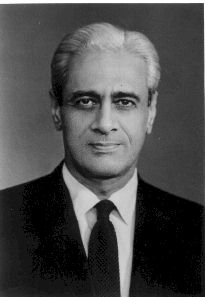
Satish Dhawan was an Indian mathematician and aerospace engineer, widely regarded as the father of experimental fluid dynamics research in India. Born in Srinagar, Dhawan was educated in India and further on in United States. Dhawan was one of the most eminent researchers in the field of turbulence and boundary layers, leading the successful and indigenous development of the Indian space programme. He succeeded M. G. K. Menon, as the third chairman of the Indian Space Research Organisation (ISRO) in 1972.
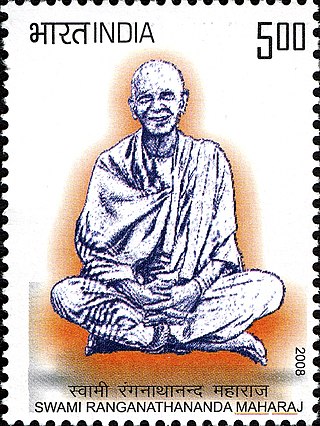
Swami Ranganathananda was a Hindu swami of the Ramakrishna Math order. He served as the 13th president of the Ramakrishna Math and Mission.

The Bhagavad-Gītā As It Is is a translation and commentary of the Bhagavad Gita by A. C. Bhaktivedanta Swami Prabhupada, founder of the International Society for Krishna Consciousness (ISKCON), commonly known as the Hare Krishna movement. This translation of Bhagavad Gita emphasizes a path of devotion toward the personal God, Krishna. It was first published in 1968 in English by Macmillan Publishers, and is now available in nearly sixty languages. It is primarily promoted and distributed by followers of ISKCON.

Kirata Kingdom in Sanskrit literature and Hindu mythology refers to any kingdom of the Kirata people, who were dwellers mostly in the Himalayas. They took part in the Kurukshetra War along with Parvatas (mountaineers) and other Himalayan tribes.

Major Hari Pal Singh Ahluwalia was an Indian mountaineer, author, social worker and Indian Ordnance Factories Service (IOFS) officer. During his career he made contributions in the fields of adventure, sports, environment, disability and social work. He is one of six Indian men and the twenty first man in the world to climb Mount Everest. On 29 May 1965, 12 years to the day from the first ascent of Mount Everest, he made the summit with the fourth and final successful attempt of the 1965 Indian Everest Expedition along with H. C. S. Rawat and Phu Dorjee Sherpa. This was the first time three climbers stood on the summit together.
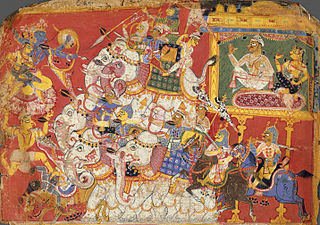
Bhagadatta was the son of Narakasura, and the king of Pragjyotisha. Bhagadatta was born from a limb of the asura called Bāṣkala. He was a renowned warrior, and was known to be a great friend of Indra. When Arjuna embarked on a conquest to help his brother Yudhishthira perform the Rajasuya Yagya, Bhagadatta was one of the first kings to be conquered by him.

In Hinduism, an astra was a supernatural weapon, presided over by a specific deity and imbued with spiritual and occult powers that caused its effect or impact. Later the word came to denote any weapon which was used by releasing it from one's hand, compared to keeping it one's hand (Shastra). In Ramayana and Mahabharata, Rama had more astras than any other warrior. It is believed that Rama possessed all astras. Various texts have stated that Arjuna possessed almost all astras except Brahmandastra & Narayanastra.
Amrita Learning is a computer-based 'adaptive learning' program in English and Mathematics. It provides interactive, audio-visual supplementary education for children of three-and-a-half years to 7th grade, for home and classroom use. Developed in collaboration with Amrita University, the content of this research-based software is in line with the NCERT/CBSE syllabi.

The Bhagavad Gita, often referred to as the Gita, is a 700-verse Hindu scripture that is part of the epic Mahabharata, dated to the second half of the first millennium BCE and is typical of the Hindu synthesis. It is considered to be one of the holy scriptures for Hinduism.
Alongside its importance in the Hindu faith, the Bhagavad Gita has influenced many thinkers, musicians including Sri Aurobindo, Swami Vivekananda, Mahatma Gandhi, Aldous Huxley, Henry David Thoreau, J. Robert Oppenheimer, Ralph Waldo Emerson, Carl Jung, Bulent Ecevit, Hermann Hesse, Heinrich Himmler, George Harrison, Nikola Tesla among others. The main source of the doctrine of Karma Yoga in its present form is Bhagavad Gita.
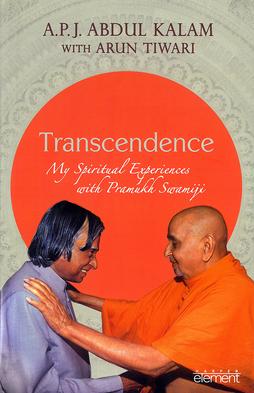
Transcendence: My Spiritual Experiences with Pramukh Swamiji is a book written by A. P. J. Abdul Kalam, the 11th President of India and a pioneering scientist. Co-authored by Professor Arun Tiwari and published by HarperCollins India, the book describes Kalam's spiritual experiences with and reflections on Pramukh Swami Maharaj, the guru and spiritual leader of the BAPS Hindu organization. Kalam recounted the spiritual transformation he experienced during his fourteen-year association with Pramukh Swami, described the inspiration he obtained from Pramukh Swami's leadership of BAPS, and expressed his vision for a society in which science and spirituality are fused. Kalam stated that he saw in Pramukh Swami “a true embodiment of transcendence,” and titled the book to reflect his belief that Pramukh Swami is gunatit, a term signifying transcendence of ephemeral qualities and the modes of nature.

Swami Samarpanananda is an Indian author and a monk of the Ramakrishna Mission, Belur Math.
The book Junglezen Sheru written by Samarpan is the story of the physical, mental and emotional growth of an orphan lion cub who refuses to accept, till last, that he is a lion.

Arun Kumar Tiwari is an Indian missile scientist, author, and professor. He has written several books and co-authored 5 books with Dr. APJ Abdul Kalam, including Wings of Fire, the autobiography of Dr. APJ Abdul Kalam, former president of India. Published in 1999, Wings of Fire has become a modern classic with over 30 reprints selling over a million copies and was translated into 18 languages.

God Talks with Arjuna: The Bhagavad Gita is a posthumously published non-fiction book by the Indian yogi and guru Paramahansa Yogananda (1893–1952). It is a two-volume work containing English translation and commentary of the Bhagavad Gita. It explicates the Bhagavad Gita's psychological, spiritual, and metaphysical elements. It was originally published in 1995 in Los Angeles by the Self Realization Fellowship, and later published in other countries and languages. The book is significant in that unlike other explications of the Bhagavad Gita, which focused on karma yoga, jnana yoga, and bhakti yoga in relation to the Gita, Yogananda's work stresses the training of one's mind, or raja yoga. The full title of the two-volume work is God Talks with Arjuna: The Bhagavad Gita – Royal Science of God Realization – The Immortal Dialogue between Soul and Spirit – A New Translation and Commentary.
References
- ↑ Samarpan. (2009). Tiya: a parrot's journey home. HarperCollins Publishers India, a joint venture with the India Today Group. ISBN 9788172238322. OCLC 502268540.
- ↑ "HarperCollinsPublishers India | Samarpan". harpercollins.co.in. Retrieved 2017-06-11.
- ↑ "The Telegraph – Calcutta (Kolkata) | Opinion | Paperback Pickings". www.telegraphindia.com. Archived from the original on October 6, 2009. Retrieved 2017-06-26.
- ↑ "TOI Crest – QUICK REVIEW – Times of India". The Times of India. Retrieved 2017-06-26.
- ↑ "Be unique: Dr APJ Abdul Kalam to youth | Latest News & Updates at Daily News & Analysis". dna. 2012-01-18. Retrieved 2017-06-26.
- ↑ Samarpanananda, Swami (October–December 2010). "Book reviews, Tiya: A Parrot's Journey Home, A P J Abdul Kalam". IMJ. 2 (3): 65–66.
- ↑ Samarpanananda, Swami (October–December 2010). "Book reviews, Tiya: A Parrot's Journey Home by A Chaterjee". IMJ. 2 (3): 85–86.
- ↑ Samarpanananda, Swami (October–December 2010). "Book Reviews, Tiya: A Parrot's Journey Home by N-Ravichandran". IMJ. 2 (3): 67–72.
- ↑ Samarpanananda, Swami (October–December 2010). "Book Reviews, Tiya:A Parrot's Journey Home by PAWAN Kumar Singh". IMJ. 2 (3): 83–84.
- ↑ "Dr Kalam Speech".
- ↑ "Science Conference/Dr Kalam speech".
- ↑ "CBSE | Academics Unit: Latest Circulars". www.cbseacademic.in. Retrieved 2017-06-26.
- ↑ Tiya: A Parrot's Journey Home. p. 1.
- ↑ Tiya: A Parrot's Journey Home. p. 117.
- ↑ Tiya: A Parrot's Journey Home. p. 23.
- ↑ Tiya: A Parrot's Journey Home. p. 149.
- ↑ Rig Veda Samhita.
- ↑ Mundaka Upanishad.